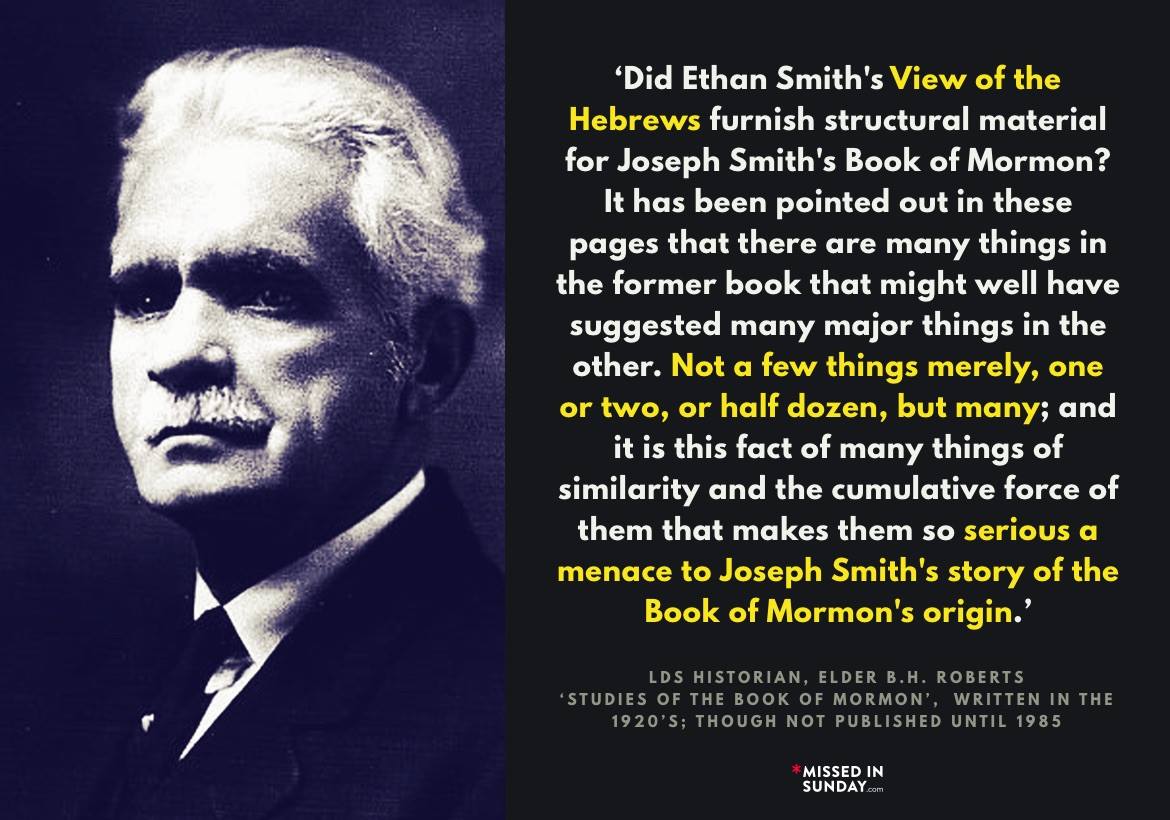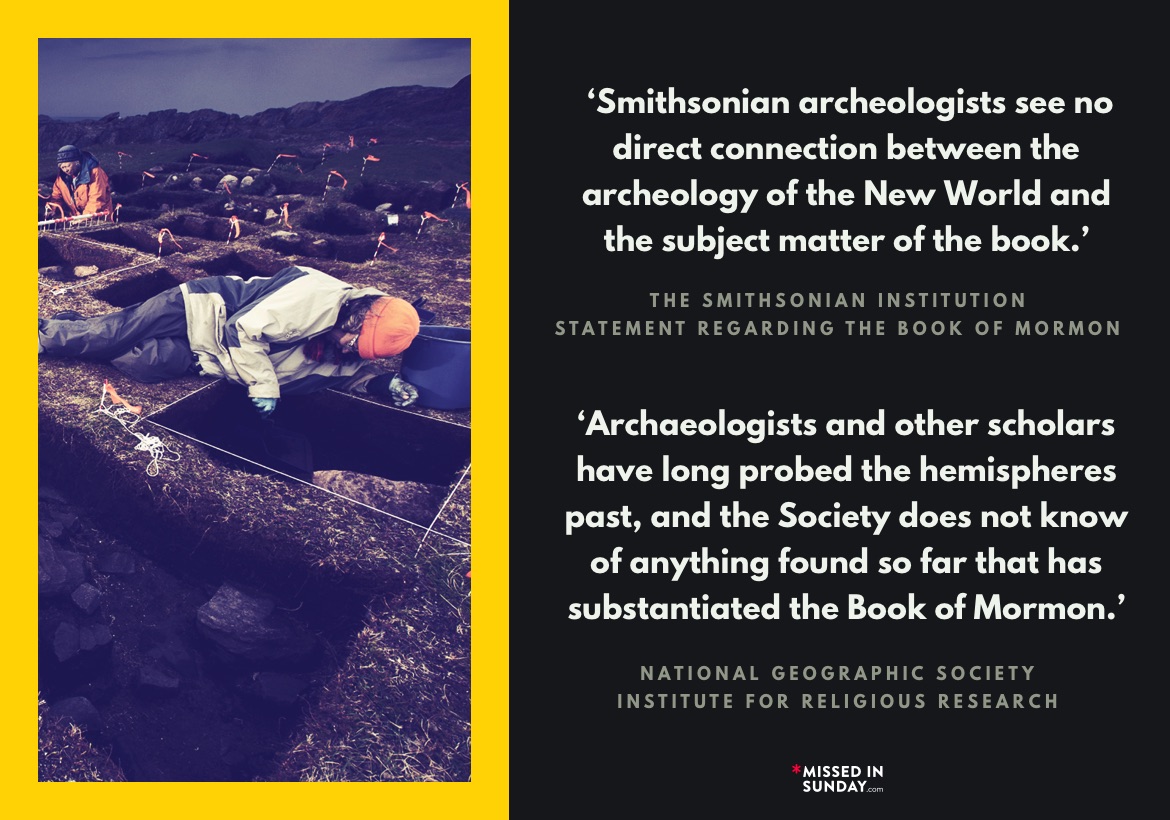Indian turning white. A Winnebago Indian, Louis Armell, living on the reservation, is said to be the object of scientific observation because for many years his skin has gradually been turning white. He is now 54 years old. He still has “copper patches” but physicians believe that if he lives a few more years he will become entirely white.
Improvement Era, April 1928 Issue 6, Page 537 (Page 91 of the linked PDF)
https://catalog.churchofjesuschrist.org/assets/4b787529-9a83-49d1-85df-d973548a6e2c/0/0
Tag: Native American
-
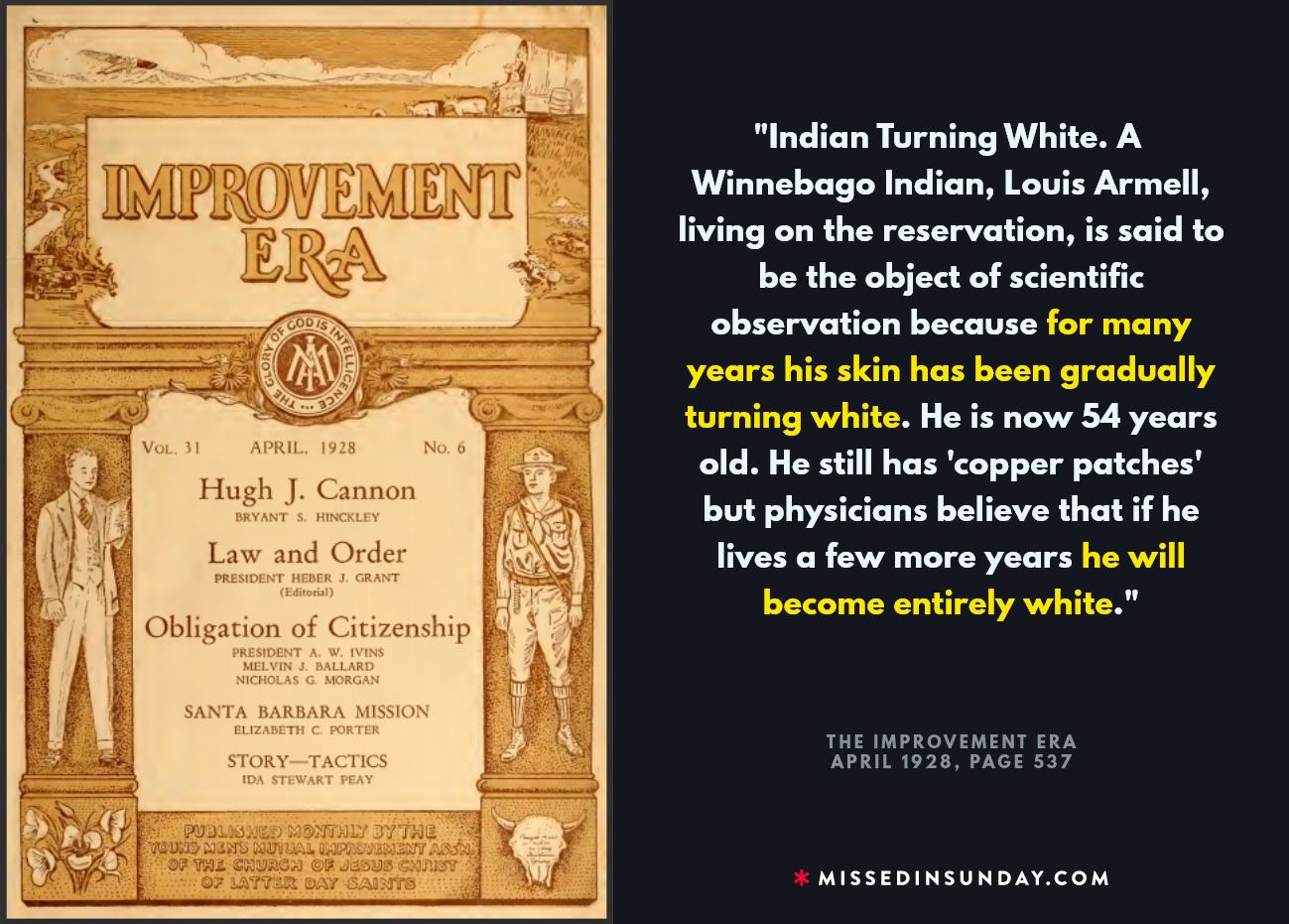
Indian Turning White, Improvement Era
-
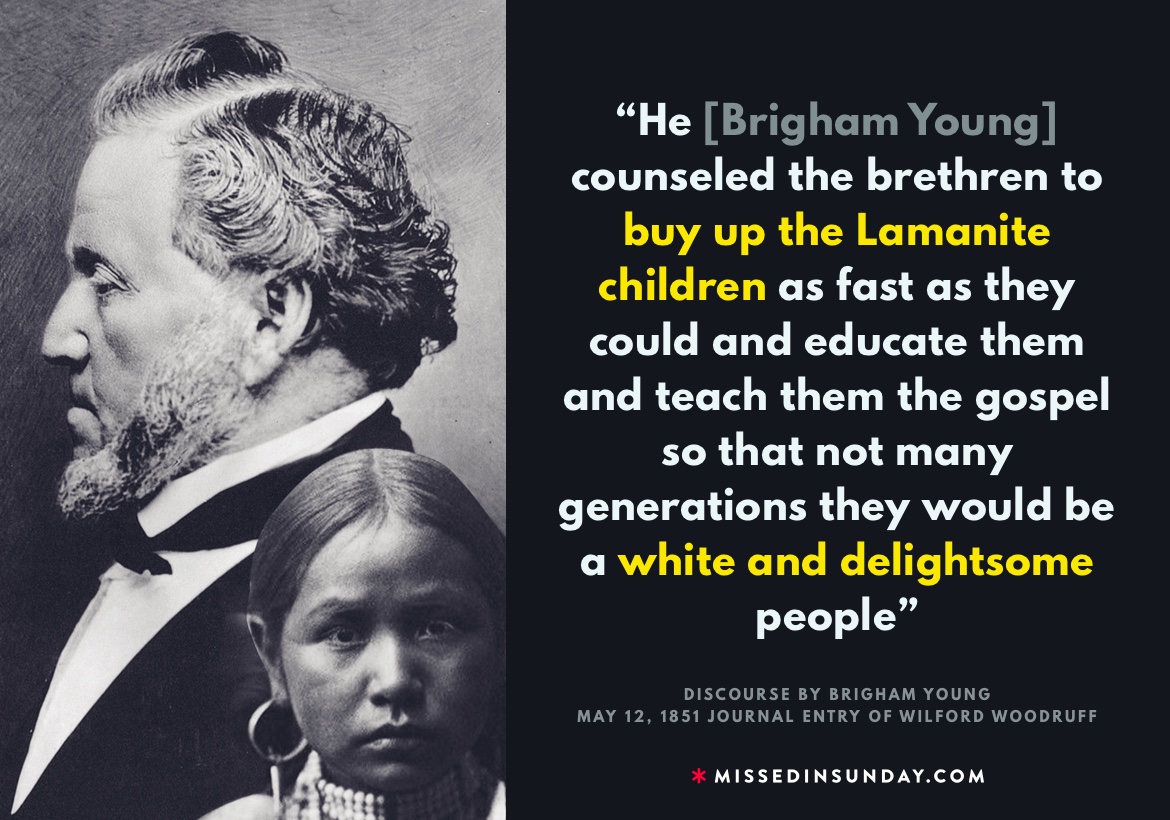
Buy up the Children
Excerpt from the journal of Wilford Woodruff: 1
May 12, 1851: At Cedar City, President Young then addressed them and said he would express his feelings upon the subject to those who wished to go home. If you were now on a mission to France, England or any other part of the earth preaching the gospel, you would not sit down and counsel together about going to get your families or go home until your mission was ended. This is of quite as much importance as preaching the gospel. for the time has now come when it is required of us to make the wilderness blossom as the rose. Our mission now is building up stakes of Zion and filling these mountains with cities and when your mission is ended, you are at liberty to go and be free and only do right. When I go on a mission, I leave my affairs in the hands of God. If my house, fields, flocks, wife or children die in my absence, I say Amen to it. If they live and prosper, I feel to say Amen to it and thank the Lord. He wished the brethren to finish the fort and secure their grain and wished the land to be surveyed so that the brethren who laid the foundation could have their choice of farms. He counselled the brethren to buy up the Lamanite children as fast as they could and educate them and teach them the gospel so that not many generations they would be a white and delightsome people for the Lord could not have devised a better plan than to have put us where we are in order to accomplish this thing.
References
References 1 Journal of Wilford Woodruff – https://archive.org/details/WoodruffWilfordJournalSelections -
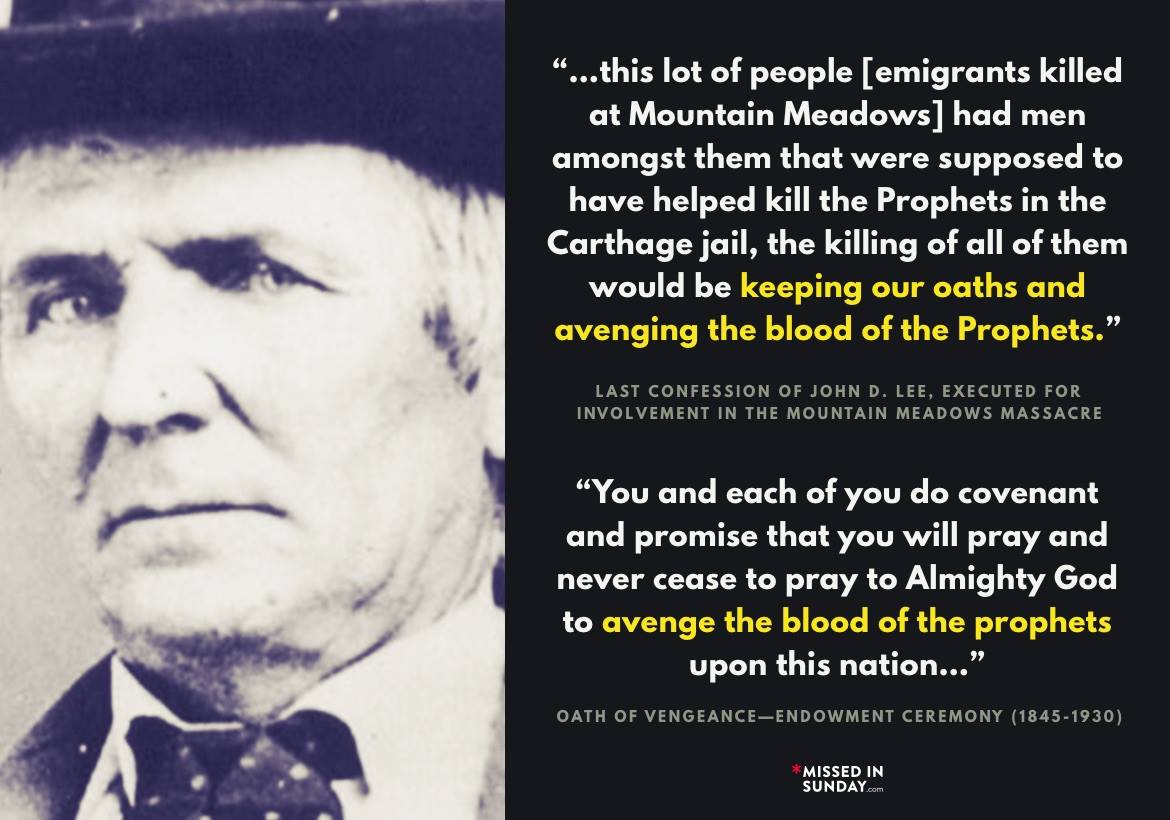
John D. Lee
September 11th marks the anniversary of the Mountain Meadows Massacre. A five day siege that culminated in the slaughter of some 120 California-bound immigrants in 1857, at the hands of Mormon militiamen (reinstated Nauvoo Legion) from Parowan, Utah.1
A month before the emigrants departed Arkansas on their journey west, Parley P. Pratt (LDS Apostle) was shot and stabbed by an estranged husband of his twelfth plural wife in the same state. Additionally there was war hysteria about a possible invasion into the Mormon territory by the U.S. government, placing the Mormon population on edge.
The wagon train of emigrants were bound for California on a route that passed through the Utah Territory. After arriving in Salt Lake, the Baker-Fancher party made their way south, eventually stopping to rest at Mountain Meadows. While camping at the meadow, nearby Mormon militia leaders, including Isaac C. Haight (LDS Stake President) and John D. Lee (adopted son, sealed to Brigham Young), joined forces to organize an attack on the wagon train.
Intending to give the appearance of Native American aggression, the militia’s plan was to arm some Southern Paiutes and persuade them to join with a larger party of their own militiamen—disguised as Native Americans—in an attack. During the militia’s first assault on the wagon train the emigrants fought back, and a five-day siege ensued. Eventually fear spread among the militia’s leaders that some emigrants had caught sight of white men and had likely discovered the identity of their attackers. As a result militia commander William H. Dame ordered his forces to kill the emigrants.
By this time the emigrants were running low on water and provisions, and allowed some approaching members of the militia—who carried a white flag—to enter their camp. John D. Lee, then local Indian agent, told them the Indians had gone, and if the Arkansans would lay down their arms, he and his men would escort them to safety. They were separated into three groups—the wounded and youngest children, who led the way in two wagons; the women and older children, who walked behind; and then the men, each escorted by an armed member of the militia.
Lee led his charges three-quarters of a mile from the campground to a southern branch of the California Trail. As they approached the rim of the Great Basin, a single shot rang out, followed by an order: “Do your duty!” The escorts turned and shot down the men, painted “Indians” jumped out of oak brush and cut down the women and children, and Lee directed the murder of the wounded.
Following the massacre, the perpetrators hastily buried the victims, leaving the bodies vulnerable to wild animals and the climate. Local families took in the surviving 17 children (all under 8 years of age), and many of the victims’ possessions were auctioned off.
Initially, the LDS Church denied any involvement by Mormons, and was relatively silent on the issue. Though an early investigation was conducted by Brigham Young, who interviewed John D. Lee on September 29th, 1857. Young sent a report to the Commissioner of Indian Affairs stating the massacre was the work of Native Americans. The Utah War delayed any investigation by the U.S. government until 1859, when Jacob Forney and Major James Henry Carleton conducted investigations. In Carleton’s investigation, at Mountain Meadows he found women’s hair tangled in sage brush and the bones of children still in their mothers’ arms. Carleton later said it was “a sight which can never be forgotten.” After gathering up the skulls and bones of those who had died, Carleton’s troops buried them and erected a cairn and cross with the inscription “Vengeance is mine, I will repay saith the Lord.”
During a tour of southern Utah, Brigham Young along with some 60 other Saints, visited the massacre site in May 1861. After viewing the inscription on the cross, Wilford Woodruff recorded President Young as saying “it should be vengeance is mine and I have taken a little.” The cross was then torn down and the rocks of the cairn were dismantled, leaving little of the original marker.
Captain James Lynch, who visited the site of the massacre in 1859, recorded his impressions:2
The scene of the fearful murder still bears evidence of the atrocious crime, charged by the Mormons and their friends to have been perpetrated by Indians but really by mormons disguised as Indians, who in their headlong zeal, bigotry and fanaticism deemed this a favorable opportunity of at once wreaking their vengeance on the hated people of Arkansas, and of making another of these iniquitious “Blood offerings” to God so often recommended by Brigham Young and their other leaders. For more than two square miles the ground is strewn with the skulls, bones and other remains of the victims. In places water has washed many of these remains together, forming little mounds, raising monuments as it were to the cruelty of man to his fellow man. Here and there may be found the remains of an innocent infant beside those of some devoted mother, ruthlessly slain by men worse than demons; their bones lie bleaching in the noon day sun a mute but eloquent appeal to a just but offended God for vengeance. I have witnessed many harrowing sights on the fields of battle, but never did my heart thrill with such horrible emotions, as when standing on that silent plain contemplating the remains of the innocent victims of Mormon Avarice, fanaticism & cruelty.
“Blood offerings” perhaps referencing the early mormon teaching of blood atonement that some crimes are so heinous that the atonement of Christ does not apply. Instead, to atone for these sins perpetrators should be killed in a way that would allow their blood to be shed upon the ground as a sacrificial offering. Brigham Young taught that a person who…
…has committed a sin that he knows will deprive him of that exaltation which he desires, and that he cannot attain to it without the shedding of his blood, and also knows that by having his blood shed he will atone for that sin, and be saved and exalted with the Gods, is there a man or woman in this house but what would say, ‘shed my blood that I may be saved and exalted with the Gods?’ All mankind love themselves, and let these principles be known by an individual, and he would be glad to have his blood shed. That would be loving themselves, even unto an eternal exaltation. Will you love your brothers or sisters likewise, when they have committed a sin that cannot be atoned for without the shedding of their blood? Will you love that man or woman well enough to shed their blood? That is what Jesus Christ meant. 3
:::
Excerpt from the last confession and statement of John D. Lee taken shortly before his execution for involvement in the Mountain Meadows massacre:4
I believed then as I do now, that it was the will of every true Mormon in Utah, at that time, that the enemies of the Church should be killed as fast as possible, and that as this lot of people had men amongst them that were supposed to have helped kill the Prophets in the Carthage jail, the killing of all of them would be keeping our oaths and avenging the blood of the Prophets.
The oath of vengeance was an addition made to the Nauvoo endowment under the direction of Brigham Young by 1845 in the Nauvoo Temple, soon after the 1844 death of Joseph Smith. Participants agreed to be bound by the following oath:
You and each of you do covenant and promise that you will pray and never cease to pray to Almighty God to avenge the blood of the prophets upon this nation, and that you will teach the same to your children and to your children’s children unto the third and fourth generation.5
References
References 1 Mountain Meadows massacre – https://en.m.wikipedia.org/wiki/Mountain_Meadows_massacre 2 Affidavit of Jame Lynch – https://www.mtn-meadows-assoc.com/james_lynch.htm 3 Journal of Discourses, vol.4, pp. 215–21. – http://contentdm.lib.byu.edu/cdm/ref/collection/JournalOfDiscourses3/id/9596 4 Last confession and statement of John D. Lee – http://www.mtn-meadows-assoc.com/jdlconfession.htm 5 Oath of vengeance, Wikipedia – https://en.wikipedia.org/wiki/Oath_of_vengeance -
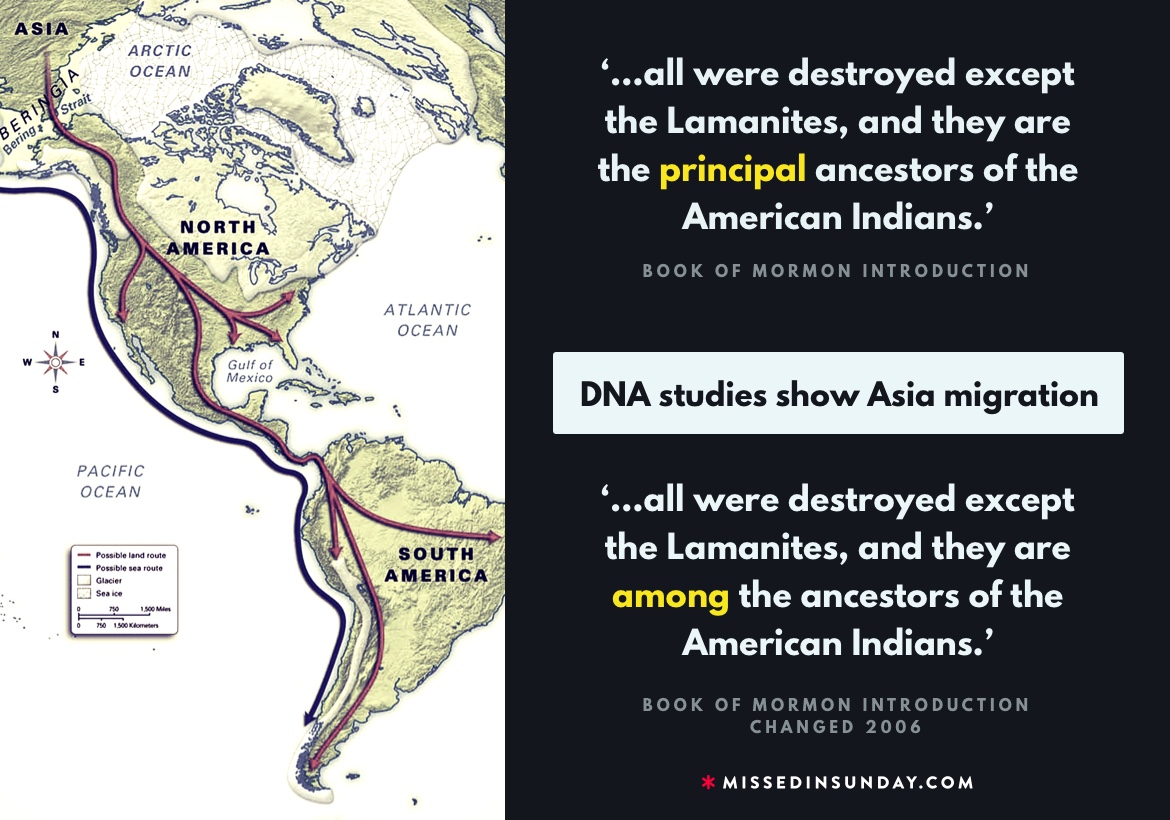
Double Helix
Image: Asianic migration routes of the Native Americans.
The introduction to the Book of Mormon:[footnote]Introduction to the Book of Mormon – LDS.org [/footnote]
The book was written by many ancient prophets by the spirit of prophecy and revelation. Their words, written on gold plates, were quoted and abridged by a prophet-historian named Mormon. The record gives an account of two great civilizations. One came from Jerusalem in 600 B.C. and afterward separated into two nations, known as the Nephites and the Lamanites. The other came much earlier when the Lord confounded the tongues at the Tower of Babel. This group is known as the Jaredites. After thousands of years, all were destroyed except the Lamanites, and they are the principal ancestors of the American Indians.
In 2006, after DNA studies began confirming Asianic migration rather than Middle Easter migration the text was changed to read:[footnote]Single word change in Book of Mormon speaks volumes – Salt Lake Tribune [/footnote]
The book was written by many ancient prophets by the spirit of prophecy and revelation. Their words, written on gold plates, were quoted and abridged by a prophet-historian named Mormon. The record gives an account of two great civilizations. One came from Jerusalem in 600 B.C. and afterward separated into two nations, known as the Nephites and the Lamanites. The other came much earlier when the Lord confounded the tongues at the Tower of Babel. This group is known as the Jaredites. After thousands of years, all were destroyed except the Lamanites, and they are among the ancestors of the American Indians.
Crash Course:
Single word change in Book of Mormon speaks volumes – Salt Lake Tribune
A genomic view of the peopling of the Americas – Harvard University
Book of Mormon and DNA Studies – Gospel Topic Essay
Simon Southerton, DNA, Lamanites and the Book of Mormon (podcast) – Mormon Stories -
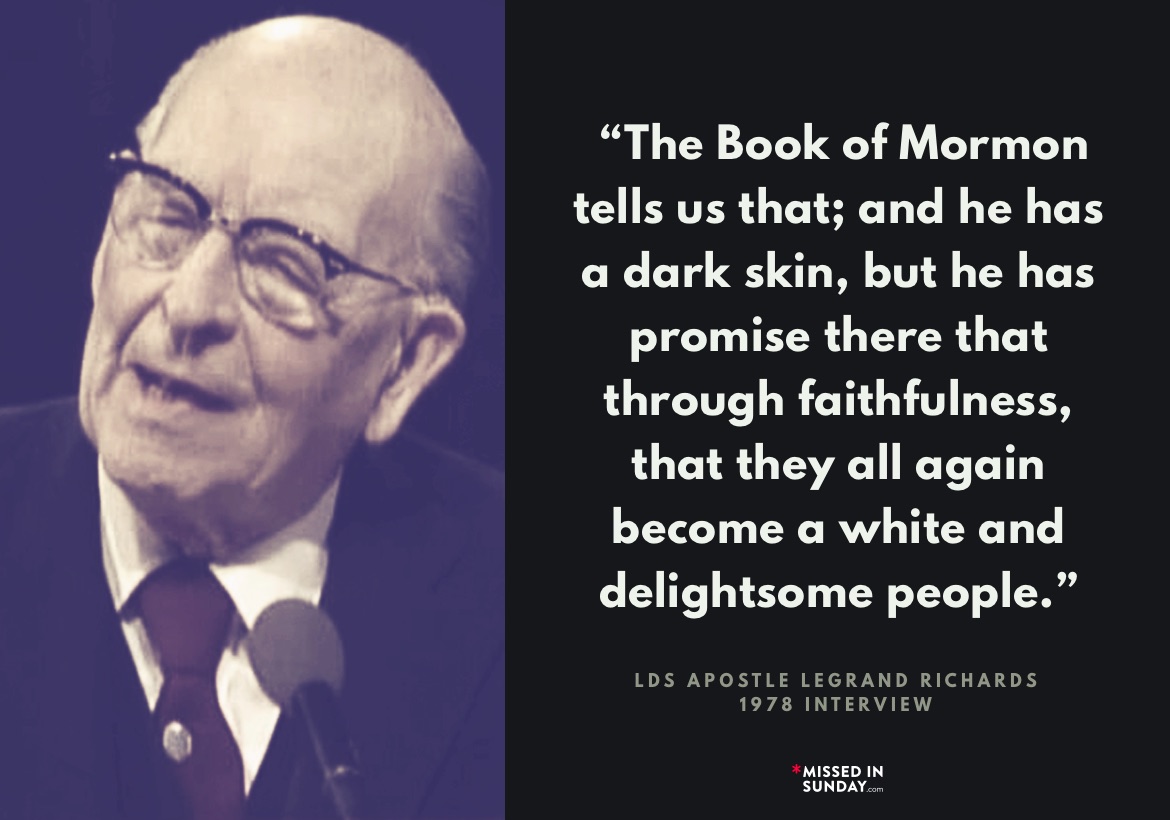
White and Delightsome
Image: Apostle LeGrand Richards
In a 1978 interview Apostle LeGrand Richards spoke on the topic of ‘giving the priesthood to the Negro’:[footnote]Interview with Apostle LeGrand Richards -16th August 1978, Church office Building [/footnote]
WALTERS (Interviewer): Is there still a tendency to feel that people are born with black skin because of some previous situation, or do we consider that black skin is no sign anymore of anything inferior in any sense of the word?
RICHARDS: Well, we don’t want to get that as a doctrine. Think of it as you will. You know, Paul said “Now we see in part and we know in part; we see through a glass darkly. When that which is perfect is come, then that which is in part shall be done away, then we will see as we are seen, and know as we are known.” Now the Church’s attitude today is to prefer to leave it until we know. The Lord has never indicated that black skin came because of being less faithful. Now, the Indian; we know why he was changed, don’t we? The Book of Mormon tells us that; and he has a dark skin, but he has a promise there that through faithfulness, that they all again become a white and delightsome people. So we haven’t anything like that on the colored thing.
Interview with Apostle LeGrand Richards – 16th August 1978, Church office BuildingBlacks and the Priesthood – Mormon ThinkBlack people in Mormon doctrine – WikipediaStatements about race in the Book of Mormon – Religious ToleranceRace and the Priesthood Essay – LDS.orgMormon racism in perspective – Elder Mark E. Peterson -
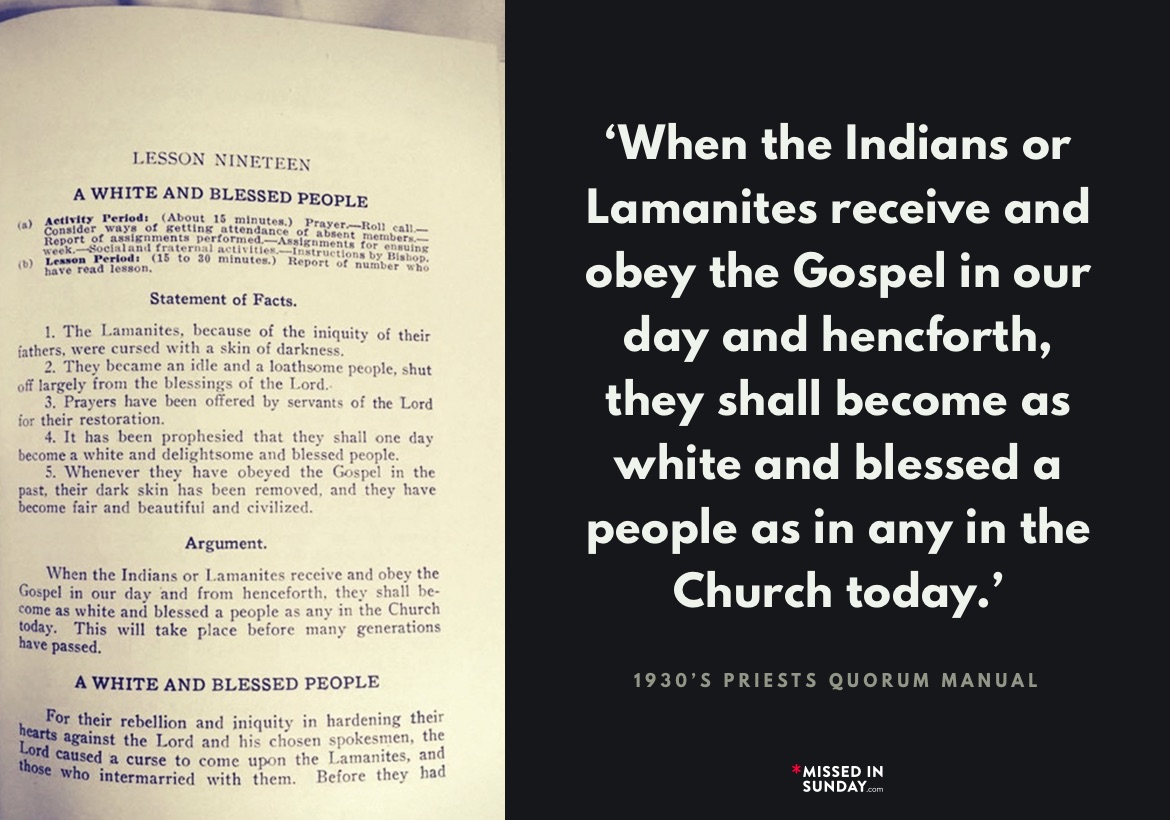
Becoming White
Lesson 19, A white and Blessed People:[footnote]Manual for the Priests’ Quorum, Nephi Jensen – Deseret News Press, 1927 [/footnote]
LESSON NINETEEN
A WHITE AND BLESSED PEOPLE
(a) Activity Period: (About 15 minutes.) Prayer.—Roll Call—Consider ways of getting attendance of absent members.—Report of assignments performed.—Assignments for ensuing week.—Social and fraternal activities.—Instructions by Bishop.
(b) Lesson Period: (15 to 30 minutes.) Report of number who have read lesson.
Statement of Facts.
- The Lamanites, because of the iniquity of their fathers, were cursed with a skin of darkness.
- They became an idle and a loathsome people, shut off largely from the blessings of the Lord.
- Prayers have been offered by servants of the Lord for their restoration.
- It has been prophesied that they shall one day become a white and delightsome and blessed people.
- Whenever they have obeyed the Gospel in the past, their dark skin has been removed, and they have become fair and beautiful and civilized.
Argument.
When the Indians or Lamanites receive and obey the Gospel in our day and from henceforth, they shall become as white and blessed a people as any in the Church today. This will take place before many generations have passed.
A WHITE AND BLESSED PEOPLE
For their rebellion and iniquity in hardening their hearts against the Lord and his chosen spokesmen, the Lord caused a curse to come upon the Lamanites, and those who intermarried with them. Before thy had…
Blacks and the Priesthood – Mormon ThinkBlack people in Mormon doctrine – WikipediaStatements about race in the Book of Mormon – Religious ToleranceRace and the Priesthood Essay – LDS.orgMormon racism in perspective – Elder Mark E. Peterson

